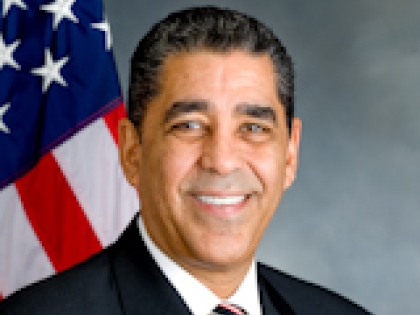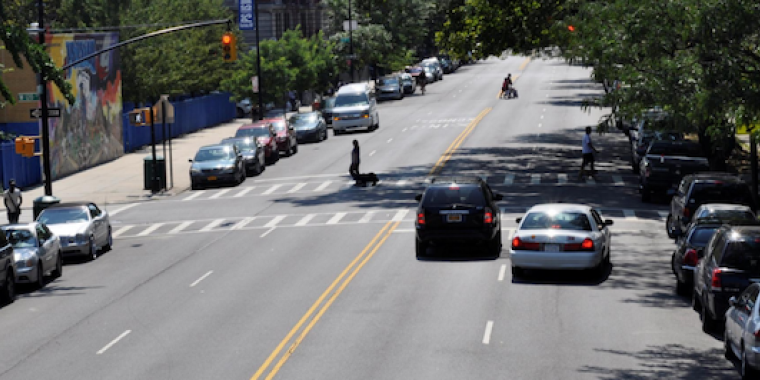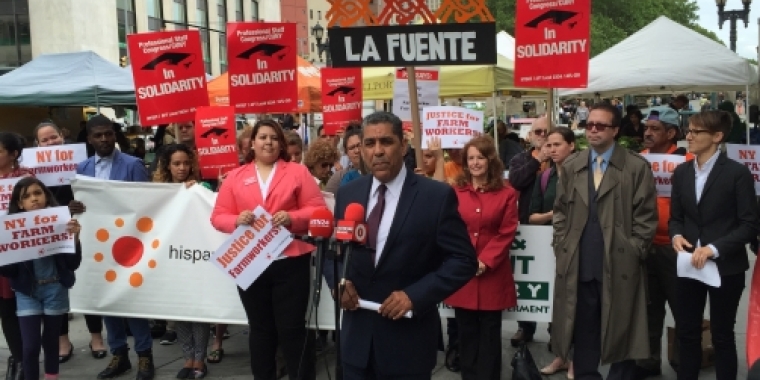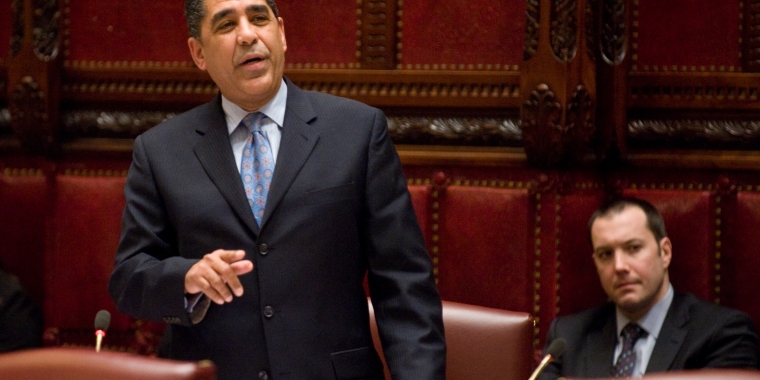
Senator Espaillat Supports Traffic Safety Measures in Harlem
Adriano Espaillat
January 12, 2014

A 10-block road diet proposed for Morningside Avenue in Harlem continues to face resistance from Manhattan Community Board 10. In the latest development, it seems the transportation committee chair of CB 10 is trying to convince neighboring Community Board 9, which contains the west side of the avenue, to amend its vote in favor of the road diet and fight against it instead. Meanwhile, Council Member Mark Levine says DOT has heard more than enough input from the community boards and urged the agency to move ahead with the project.
Tonight, CB 10′s transportation committee, which has a history of failing to support street safety projects, is set to continue its discussion of the Morningside Avenue proposal, after the full board refused to take action on the matter last week. CB 10′s committee has been discussing the project since at least as far back as September, with members regularly blasting the road diet. Tonight’s committee meeting is scheduled for 6:30 p.m. in the third-floor conference room of the Harlem State Office Building, 163 West 125th Street.
CB 9 passed a resolution in support of the plan in November [PDF], but board staff and transportation committee chair Carolyn Thompson tell Streetsblog that the committee will reopen the matter at its next meeting on February 6. Under consideration: An amendment that would ask DOT to “identify alternative measures to lane reductions.”
Reducing the number of through lanes from two to one in each direction is the central component of the Morningside Avenue safety plan, imposing order on an excessively wide street that currently encourages a majority of drivers to speed, according to DOT counts. The road diet also creates space for a center median with concrete pedestrian islands and left-turn pockets. Vehicle flow would essentially not be affected, since left-turning vehicles already occupy an entire lane in the current design, except to become safer and more predictable. These features, common in other traffic calming plans throughout the city, have reduced injury-causing crashes 40 percent on Gerritsen Avenue in Brooklyn, which like Morningside borders a park.
The push against the road diet appears to have originated in CB 10, which has fought against traffic calming elsewhere in the neighborhood. Karen Horry, acting chair of CB 10′s transportation committee, said last month that she contacted Thompson, the CB 9 committee chair, to express her surprise that CB 9′s resolution didn’t ask DOT to eliminate the road diet.
“It was agreed between both boards that there will be no lane reduction… CB 9 forgot to put that part on their resolution,” CB 9 staffer Hleziphi Zita told Streetsblog. “So that is why they had to do an amendment.”
Brad Taylor, a CB 9 member who wrote the resolution supporting DOT’s plan that passed in November by a 23-4 vote, with one abstention, was confused why Thompson is now moving forward on an amendment against the road diet. “I don’t see why the two [resolutions] need to be identical, frankly,” he said. “If CB 10 has issues, let them express them.”
Horry told DOT last month that “the community has a great deal of concern about the lane reductions,” but the community group that requested the traffic calming plan doesn’t see it that way.
“There’s been nothing so far that’s been raised at the community board meetings in opposition to these plans that indicate that the lane closures will be a problem,” said Jonathon Kahn, a steering committee member of the North Star Neighborhood Association, which requested the traffic calming plan after its members said they felt crossing Morningside to access the park was dangerous. ”North Star very much wants to work with CB 10 to figure out a solution. So far the conversation from our perspective has disproportionately been focused on traffic concerns and parking,” he said. “We’d like to see the conversation be more balanced.”
There were 102 injuries along this ten-block section of Morningside Avenue from 2007 to 2011, according to DOT data. With this in mind, Council Member Mark Levine urged DOT to move forward on the plan. “Time actually matters here. Every day we delay is a risk of new injuries, so I feel some urgency,” he told Streetsblog. “There’s been a significant amount of public consultation so far, by my count eight or nine meetings between Community Boards 9 and 10. A significant opportunity for community input.”
Update: Levine, along with State Senator Adriano Espaillat, sent a letter to incoming Transportation Commissioner Polly Trottenberg today asking DOT to move forward with the project. “We would like the DOT to err on the side of the residents who have placed a priority on safety,” they wrote [PDF]. “We are ready to support the implementation of this popular plan.”
Streetsblog’s requests for comment from Council Member Inez Dickens, who also represents the Morningside Avenue project area, were not returned.
Oddly, even as the boards are working against the road diet, they say they want bike lanes, which DOT left out of its design. A dedicated group of community members have consistently shown up at CB meetings, urging DOT to include bike lanes in its plan.
Area resident J.P. Partland has created an online petition for bike lanes on Morningside, and the advocacy has paid off: CB 9 staff told Streetsblog that the board’s transportation committee will also consider an amendment asking for bike lanes next month. Even Stephanie Howze, a CB 10 committee member who opposes the road diet, said last month that the committee should honor the request and include a recommendation for bike lanes in its resolution on DOT’s proposal.
While CB 9 and CB 10 deserve credit for listening to the bike lane activists, a position for bike lanes but against the road diet doesn’t make much sense. In order to claim the necessary space for bike lanes without eliminating parking lanes, you need to implement a road diet.
Share this Article or Press Release
Newsroom
Go to NewsroomUptown Games Races to 5th Anniversary
April 3, 2016

Letter to the Editor: Farmworkers deserve fairness
April 3, 2016

